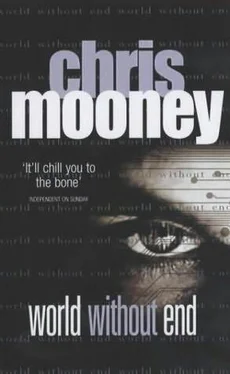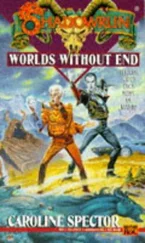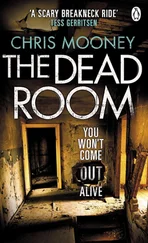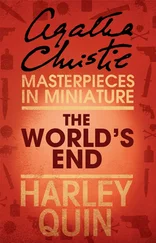Chris Mooney - World Without End
Здесь есть возможность читать онлайн «Chris Mooney - World Without End» весь текст электронной книги совершенно бесплатно (целиком полную версию без сокращений). В некоторых случаях можно слушать аудио, скачать через торрент в формате fb2 и присутствует краткое содержание. Жанр: Триллер, на английском языке. Описание произведения, (предисловие) а так же отзывы посетителей доступны на портале библиотеки ЛибКат.
- Название:World Without End
- Автор:
- Жанр:
- Год:неизвестен
- ISBN:нет данных
- Рейтинг книги:4 / 5. Голосов: 1
-
Избранное:Добавить в избранное
- Отзывы:
-
Ваша оценка:
- 80
- 1
- 2
- 3
- 4
- 5
World Without End: краткое содержание, описание и аннотация
Предлагаем к чтению аннотацию, описание, краткое содержание или предисловие (зависит от того, что написал сам автор книги «World Without End»). Если вы не нашли необходимую информацию о книге — напишите в комментариях, мы постараемся отыскать её.
World Without End — читать онлайн бесплатно полную книгу (весь текст) целиком
Ниже представлен текст книги, разбитый по страницам. Система сохранения места последней прочитанной страницы, позволяет с удобством читать онлайн бесплатно книгу «World Without End», без необходимости каждый раз заново искать на чём Вы остановились. Поставьте закладку, и сможете в любой момент перейти на страницу, на которой закончили чтение.
Интервал:
Закладка:
In reality, Delburn was a CIA front, the temporary base of operations for the Information Warfare Analysis Center. The five-floor, nondescript brick building that housed them was owned and operated by the CIA and used the latest technological advances in bio-metric security to keep the true activities of the company safe from prying eyes and ears.
The conference room was painted a pale yellow and had floor-to-ceiling windows that offered a partial aerial view of the bustling activity of downtown Austin's sprawling University of Texas campus. Steve Conway was alone, the dream still clinging to him. He looked away from the window, went over to the coffeemaker, and poured himself another cup.
Mounted on the opposite wall was a flat-screen TV hooked up to a desktop computer.
Conway finished pouring his coffee and then drew the blinds. He picked up the remote from the long table, sat down, leaned back in the comfortable leather executive chair and hit the MENU button. Using the remote, he moved the arrow down until the word ROMU-LAN was highlighted and then hit the PLAY button.
The TV screen came to life with the crisp, vivid picture of a man dressed head-to-toe in what looked like futuristic combat gear. The black, lightweight outfit and attached motorcycle-style helmet was, in reality, a working prototype of a high-tech military-combat suit being developed by the Army's Future Warrior combat system.
The narrator began a Discovery Channel-type overview of the military suit. The two small boxes attached to the back of the utility belt contained a power supply fueled by liquid hydrogen, the other a climate-conditioning system that provided either warm or cool air to the soldier wearing the suit. The weapon's pod mounted on the soldier's wrist responded to voice commands, which, when activated, would fire either rounds of bullets or launch one of the four projectiles that could take down a car, even a helicopter. Mounted on the opposite wrist was a small, rectangular box containing a keypad and computer rolled into one unit, the heart and brain of the suit.
On the screen the soldier ran across an open field. Out of nowhere came a pistol shot, its sound erupting over the conference room's ceiling-mounted speakers. Conway watched as the soldier collapsed to the ground.
The soldier was not hurt; the suit's outer shell consisted of a layer of body armor. Microsensors attached to the soldier's skin relayed his life signs to the nearby base camp; orders were relayed back to him through the receiver placed inside the helmet. The enemy could not hear the encrypted voices speaking over the helmet.
The soldier made a hand gesture to signal he was okay. No one was around to see it. The sensors placed inside the fingertips of his gloves relayed the gesture through microprocessors and then simultaneously transmitted the data back to base camp and across the visors of the other soldiers.
The helmet itself was a technological marvel; it offered night vision, could pick up thermal heat signatures given off by any living creature, and allowed a soldier to zoom in on a target and then transmit the image and its coordinates to both base camp and onto the visors of other soldiers. The carbon nanotubes installed in the helmet's visor protected the soldier from an attack from a new and potentially lethal technology: blinding laser weapons.
The next demonstration was the reason why Conway was in Austin.
The soldier stood up. For the purposes of the video, the soldier typed the five-digit code into the keyboard instead of whispering the voice-activated command. When he was done, the soldier faced the camera.
Conway leaned forward in his chair and stared at the screen. This was his favorite part.
Blink and you' II miss it.
The soldier waved to the camera… And then vanished.
"Jesus," Conway mumbled under his breath. The transition was so fast, so fluid, that the first time he saw a demonstration, his mind couldn't process what had just happened had, in fact, refused to believe what it had just witnessed.
This wasn't some Hollywood special effect. The technology used to make the soldier vanish was called optical camouflage. The wrist-mounted computer took pictures of the soldier's surroundings and using real-time pixel replication "painted" the images on the suit through thousands of fiber-optic cameras. Thanks to recent advances in computer microprocessors, the cloaking happened so fast, the transition so fluid, that it looked like the soldier had vanished into thin air.
With the suit's power supply, a soldier could stay cloaked for more than eight hours.
Invisibility was now a reality.
A soldier could sneak into an enemy camp and kill everyone in their sleep, could sneak across enemy lines and plant a bomb, day or night, it didn't matter. Wearing this suit, you could walk up to a terrorist target and blow the back of his head off and no one would be able to see you.
The possible scenarios and potential applications were endless.
Which was why Angel Eyes was willing to pay cash for the working prototype.
Angel Eyes was the code name given to the man who, over a six-year period, had stolen several high-tech weapons from U.S. companies, most of them working prototypes. The stolen weapons never appeared on any black markets; they were never used to wage a battle on U.S. soil or against a foreign company. It was as if the weapons had simply vanished.
The true identity of Angel Eyes, his race and age, what he did for a living all of it was unknown. The IWAC team believed he had a group of professionals who worked for him. The team didn't know if Angel Eyes was operating out of the U.S. or, more disturbing, what the man's true agenda was. Was he going to use the weapons for some sinister purpose whose agenda would one day announce itself to the world like the Oklahoma bombing? Theories abounded.
What IWAC did know was the name of Angel Eyes's last two victims.
A sticky foam spray used as a nonlethal means of riot control had been around for several years. You sprayed the target, the foam formed and then hardened, and the person was stuck to the floor or street, immobilized. No one died. A great, nonlethal weapon.
The problem was clean-up. It was a time-consuming, pain-in-the-ass process that was very, very expensive. Massive police departments like Los Angeles and prisons, where the sticky foam would be the most useful, wanted to wait until the technology was more refined. A twenty-two-year-old brainiac chemist from Berkeley named Jonathan King stepped in and developed a foam that, when sprayed with a certain chemical compound, turned into dust.
The working prototype and design schematics for the spray gun, along with all the backup information on the chemical compounds that made the foam work, disappeared from the Berkeley-based lab. Three days later, at a junkyard in St. Paul, Minnesota, a man and his four-year-old son were looking at a part on a 1987 Buick Century when the boy heard what sounded like someone crying. The father pressed his ear against the trunk and heard a dry, tired voice just barely stronger than a whisper crying for help.
King had been beaten unconscious, and someone had poured Drano down his throat. He was airlifted to the hospital and by the time he arrived had slipped into a coma.
Six weeks passed and then on a cold March morning King woke up. The police came by for questioning, but the problem was that King had suffered severe brain damage. He couldn't talk, but he could write, and when asked the name or a description of the man who had done this to him, all King could (or would) write were the words Angel Eyes. King suffered a heart attack later that night and died.
The major break came two years ago, with thirty-four-year-old Alan Matthews, an MIT graduate who was developing for the government a portable spying device that could pick up the magnetic signals from any unshielded computer monitor or laptop screen any CRT screen. Using a specialized antenna, a person sitting inside a car could stare at the device's screen and watch as you typed your PIN number into the ATM machine to access your account; could read your e-mail or document as you were typing it; could even watch you perform business transactions that ranged from the simple credit-card order on the Internet to buying and trading stocks. Unlike its predecessors, this device had been designed to resemble a laptop, making it inconspicuous. The device's spying implications were endless.
Читать дальшеИнтервал:
Закладка:
Похожие книги на «World Without End»
Представляем Вашему вниманию похожие книги на «World Without End» списком для выбора. Мы отобрали схожую по названию и смыслу литературу в надежде предоставить читателям больше вариантов отыскать новые, интересные, ещё непрочитанные произведения.
Обсуждение, отзывы о книге «World Without End» и просто собственные мнения читателей. Оставьте ваши комментарии, напишите, что Вы думаете о произведении, его смысле или главных героях. Укажите что конкретно понравилось, а что нет, и почему Вы так считаете.












